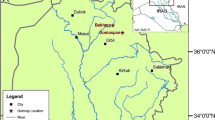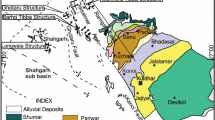Summary
In the Lower Carboniferous limestones and shales of the Benbulben Range, Counties Sligo and Leitrim, northwestern Ireland, a suite of carbonate nodules, about 1 to 4 cm in diameter, has been sampled and investigated by thin sectioning. The nodules consist of micritic, peloidal and fenestral fabrics. Many of them contain relics of desma bearing demosponges and hexactinellid sponge skeletons. The nodules are interpreted as calcified siliceous sponges. Micrite and peloids have been formed via microbial activity during the decay of the soft sponge tissue. The actual processes are deduced from Recent examples investigated at Lizard Island, Autralia, byReitner (1993). The skeletal opal was dissolved very early. In places where the skeleton was already embedded in micrite the spicules are preserved as molds cemented by granular ferroan calcite. The nodules were extensively inhabited by agglutinating polychaetes and bored by sponges. Micrite clasts have been exported to the surrounding seafloor before the sponges were completely covered by sediments. Fenestral fabrics represent primary sponge cavities, that may be enlarged due to volume reduction of the soft tissue during calcification. Some originated from non-calcification of decaying tissue. The granular calcite cement, filling the fenestral fabrics, contains relics of spicules and faintly visible peloids floating unsupportedly in the cement. These peloids were probably produced in situ by calcification of organic mucilages that filled the cavities almost entirely. It is evident that most diagenetic processes occurring within the sponges happened on the seafloor, most likely within the still living individuals. Possibly the nodules represent a precursor stage of mud mound development.
Similar content being viewed by others
References
Bathurst, R.G.C. (1975): Carbonate sediments and their diagenesis (2nd edition).—Develop. Sediment.12, 658pp. Elsevier, Amsterdam
Bracichert, T.C. (1991): Environmental control on fossilization of siliceous sponge assemblages: a proposal.—In:Reitner, J. &Keupp, H. (eds.): Fossil and recent sponges.—543–553, Berlin (Springer).
Bourque, P.-A. &Boulvain, F. (1993): A model for the origin and petrogenesis of the red stromatactis limestone of Paleozoic carbonate mounds.—J. Sed. Petrol.63/2, 607–619, Tulsa
Bourque, P.-A. &Gignac, H. (1983): Sponge-constructed stromatactis mud mounds, Silurian of Gaspé.—J. Sed. Petrol.53, 521–532, Tulsa
Bridges, P.H. &Chapman, A.Y. (1988): The anatomy of a deep water mud-mound complex to the south-west of the Dinantian Platform in Derbyshire, U.K..—Sedimentology35, 139–162, Oxford
Brunton, F.R. &Dixon, O.A. (1994): Siliceous sponge-microbe biotic associations and their recurrence through the Phanerozoic as reef mound constructors.—Palaios9, 370–387, Tulsa
Buczinsky C. &Chafetz, H.S. (1991): Habit of bacterially induced precipitates of calcium carbonates and the influence of medium viscosity on mineralogy.—J. Sed. Petrol.61, 226–233; Tulsa
Cayeux (1935): Les roches sedimentaires des France; roches carbonatées.—463 pp., Paris (Masson)
Chafetz, H.S. (1986): Marine peloids: A product of bacterially induced precipitation of calcite.—J. Sed. Petrol.56, 812–817, Tulsa
Dunham, R.J. (1969): Early vadose silt in Townsend Mound (reef), New Mexico.—In: Depositional environments in carbonate rocks; a symposium.—Soc. Econ. Min. Paleont., Spec. Publ.14, 139–181, Tulsa
Finks, R.M. (1960): Late Paleozoic sponge faunas of the Texas Region. The siliceous sponges.—Bull. Amer. Mus. Nat. Hist.120, 1–160, Washington
Flügel, E. & Steiger, T. (1981): An Upper Jurassic sponge-algal buildup from the northern Frankenalb, West Germany.—In:Toomey, E.F. (ed.): European fossil reef models.—Soc. Econ. Min. Paleont., Spec. Publ.30, 371–397, Tulsa
Fritz, G.K. (1958): Schwammstotzen, Tuberolithe und Schuttbreccien im weißen Jura der schwäbischen Alb.—Arbeiten aus dem Geologisch-Paläontologischen Institut der Technischen Hochschule Stuttgart, N.F.13, 113 pp., Stuttgart
Gallard, C. (1983): Les biohermes a sponiaires et leur environment dans L’Oxfordien du Jura Meridional.—Documents des Laboratoires de Géologie Lyon90, 515 pp.
Grau, R. & Warnke, K. (1990): Das Unter-Karbon am Benbulben, County Sligo, Republic of Ireland.-Diplom-Arbeit Universität Göttingen (unpublished), 128 pp., Göttingen
Kaufmann, B. & Michel, C. (1991): Das Unter-Karbon am Truskmore, Counties Sligo und Leitrim, Republic of Ireland. —Diplom-Arbeit Universität Göttingen (unpublished), 214 pp., Göttingen
Keupp, H., Reitner, J. &Salomon, D. (1989): Kieselschwämme (Hexactinellida und ‘Lithistida’) aus den Cipit-Kalken der Cassianer Schichten (Karn, Süd-Tirol).—Berliner geowissen-schaftliche Abhandlungen (A)106, 221–241, Berlin
Kliberg, D. (1985) Über einen Fund vonTerebella’ lapilloides Münster (1833) aus dem Mitteloxford der mittleren Frankenalb. —Geologische Blätter Nordost-Bayern34/35, 125–136, Erlangen
Land, L.S. (1976): Early dissolution of sponge spicules from reef sediments, North Jamaica.—J. Sed. Petrol.46, 967–969; Tulsa
Lang, B. (1989): Die Schwamm-Biohermfazies der nördlichen Frankenalb (Urspring; Oxford, Malm): Mikrofazies, Palökologie, Paläontologie.—Facies,20, 199–274, Erlangen
Macintyre, I.G. (1985): Submarine cements—the peloidal question. —In:Schneidermann, N. & Harris, P.M. (eds.): Carbonate cements.—Soc. Econ. Min. Paleont., Spec. Publ.36, 109–116, Tulsa
Oswald, D.H. (1955): The Carboniferous rocks between the Ox Mountains and the Donegal Bay.—Quart. J. Geol. Soc. London111, 167–183, London
Reitner, J. (1992): Coralline Spongien. Der Versuch einer phylogenetisch-taxonomischen Analyse.-Berliner geowissenschaftliche Abhandlungen (E)1, 352 pp., Berlin
— (1993): Modern cryptic microbialite/metazoan facies from Lizard Island (Great Barrier Reef, Australia). Formation and Concepts.—Facies29, 3–40, Erlangen
Reitner, J. &Keupp, H. (1991): The fossil record of the haplosclerid excavating spongeAka deLaubenfels.—In:Reitner, J. &Keupp, H. (eds.) Fossil and recent sponges.—102–120, Berlin (Springer)
Reitner, J., Neuweiler, F., Flajs, G., Vigener, M., Keupp, H., Paul, J., Warnke, K., Dingle, P., Hensen, C., Schäfer, P., Leinfelder, R.R., Hüssner, H. &Kaufmann, B. (1995): Mud mounds: A polygenetic spectrum of fine-grained carbonate buildups.—Facies32, 1–70, Erlangen
Richter, D.K. &Füchtbauer, H. (1978): Ferroan calcite replacement indicates former magnesian calcite skeletons.— Sedimentology25, 843–860, Oxford
Schwarzacher, W. (1961): Petrology and structure of some Lower Carboniferous reefs in northwestern Ireland.—Bull. Amer. Assoc. Petrol. Geol.45, 1481–1503, Tulsa
Schwarzacher, W. (1978): The petrology and sedimentology of the Middle Glencar Limestone, Sligo Basin, Northwestern Ireland—a study in bed formation.—In:Bathurst, R.G.C. & Hubbard, J.A.E.B. (eds.): Seminar: Processes in carbonate environments. —1.2.-1.4 London
Simpson, T.L. (1984): The cell biology of sponges.—662 pp., New York (Springer)
Trammer, J. (1989): Middle to Upper Oxfordian sponges of the Polish Jura.—Acta geologica Polonica39, 49–91, Warszawa
Volkmer-Ribeiro, C. &Reitner, J. (1991): Renewed study of the type matreial ofPalaeospongilla chubutensis Ott and Volkheimer (1972).—In:Reitner, J. &Keupp, H. (eds.): Fossil and recent sponges.—121–133, Berlin (Springer)
Warnke, K. (1994) Die unter-karbonischen Mud Mounds in den Counties Sligo und Leitrim, Nordwest-Irland. Fazies, Bildungsbedingungen und Diagenese.—Documenta Naturae88, 72 pp., München
Warnke, K. & Meischner, D. (1995): Origin and depositional environments of Lower Carboniferous mud mounds of Northwestern Ireland.—In:Reitner, J., Neuweiler, F., Flajs, G., Vigener, M., Keupp, H., Paul, J. Warnke, K., Dingle, P., Hensen, C., Schäfer, P., Leinfelder, R.R. Hüssner, H. & Kaufmann, B. (1995): Mud mounds: A polygenetic spectrum of fine-grained carbonate buildups.—Facies32, 36–42, Erlangen
Webb, G.E. (1987): Late Mississippian thrombolite bioherms from the Pitkin Formation, Northern Arkansas.—Bull. Geol. Soc. America99, 686–698, Boulder
Author information
Authors and Affiliations
Rights and permissions
About this article
Cite this article
Warnke, K. Calcification processes of siliceous sponges in Viséan Limestones (Counties Sligo and Leitrim, Northwestern Ireland). Facies 33, 215–227 (1995). https://doi.org/10.1007/BF02537453
Received:
Revised:
Issue Date:
DOI: https://doi.org/10.1007/BF02537453




